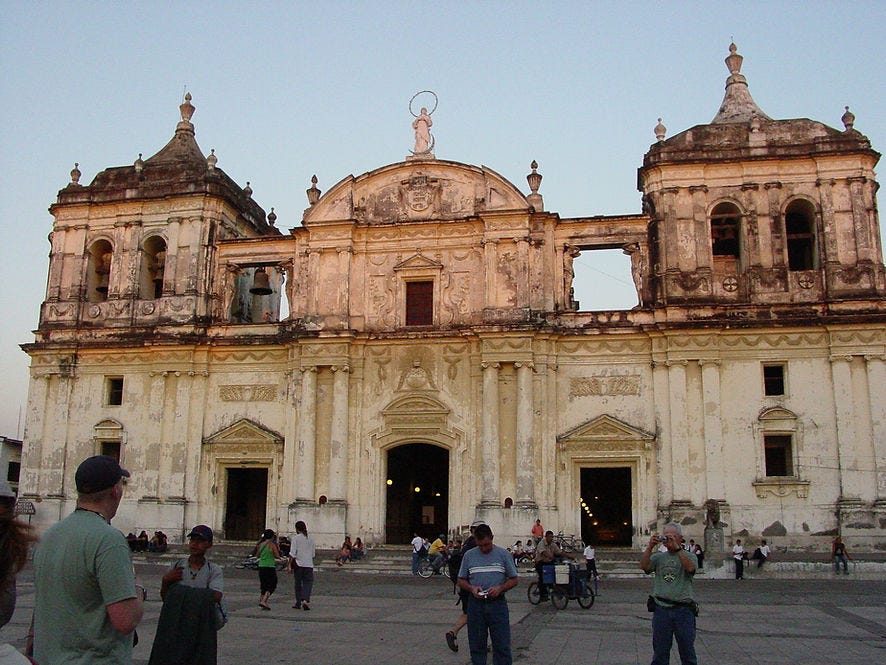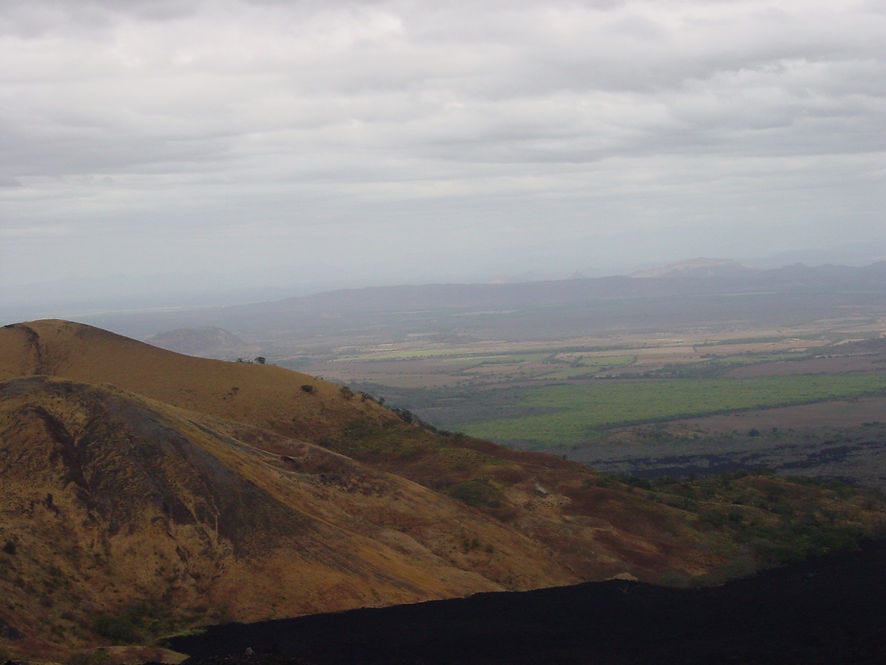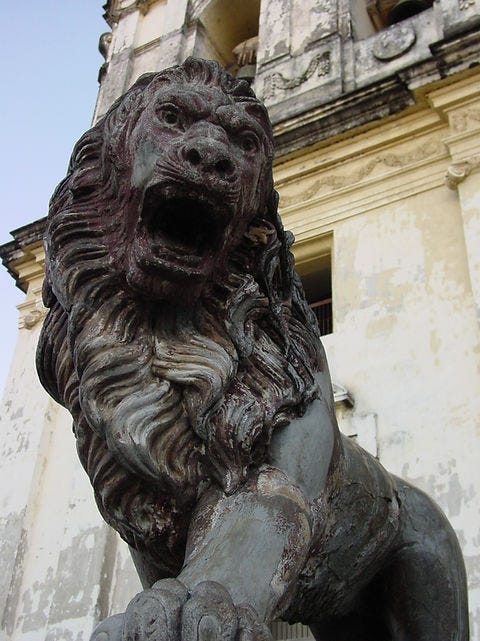Bill Gates is taking over the world, starting with Nicaragua.
Or maybe it's just confusion over plans.
Parts from this post originally ran on March 13, 2007, and May 4, 2012. It has been edited and reworked with additional content added.
Leon, Nicaragua—birthplace of the revolution with murals celebrating it at every turn—has a giant cathedral that wasn't supposed to be there.
The cathedral was built by mistake.
A huge, gorgeous, Baroque mistake. The cathedral was intended for Panama, but somehow there was a mix-up in two sets of plans and construction began in León, Nicaragua. Panama got stuck with the smaller building.
My first missions trip to Nicaragua was in 2004, but by 2011, my last trip after having seen houses, a church, and a farm built by our teams, I could see the heavy impact of tourism in general in the country.
The once sparse beach with minimal development had turned into a place where American and European "eco tourists" could feel good about themselves for traveling without realizing the irony of how much their demand had impacted the place they thought they were seeing untouched. Sprawling patios and construction to make them feel comfortable on the beach as they lounged in expensive bikinis and wet suits replaced what had been a simple slab covered by a basic roof and palm fronds, frequented by children running around trying to sell the jewelry they'd made.
It wasn't just the beach that had changed.
Momotombo, the volcano we hiked up in our t-shirts and shorts and cautiously hiked down (one fellow slid down, ripping out the entire back of his shorts on the sharp volcanic rock) was an empty place of echoes at the time, requiring a paid armed guard, an off-duty police officer, to come with the group for protection.
But now it is featured by the hip world travelers and their selfies on Instagram as a must-visit place, complete with "surfing" down the side and recommended expensive hiking gear to use.
The huge cathedral has always fascinated me on the trips to Nicaragua. It is the largest cathedral in Central America.
For eight years, I photographed its worn walls, the lions that guard the front, the thick red wooden doors. Such massive walls and arches. I’ve sketched the cathedral more times than I can remember. Each of my trip journals have a drawing or two of the cathedral gracing the pages.
It’s just down the street from Italian Pizza (now also a hostel) which is owned by a Lebanese man the group stayed with. We ate there every night, until he built a kind of hotel at the edge of town better suited for large groups.
"Breakfast is between 7 and 7!" he'd say in his thick Middle-Eastern accent, and then chuckle with us. He ran a strict schedule.
Or "would you like chicken or chicken for dinner, Julie?" he'd say to me when we were back from a day's work, and I'd laugh because he knew. His chicken always had a hint of cinnamon and was delicious.
The great lions guard the front of the cathedral.
The square in front of the cathedral was almost always full of activity. People selling, beggars hoping for something.
One mid-summer trip, our small group was in the plaza with hundreds of other people. A Catholic celebration of some sort was going on, and a man dressed in a strange costume spun and danced in the dark, fireworks spraying off of him and shooting about and above the crowd. He was a blur that glowed in the rich dark noise of the square, vendors calling out and people shouting.
I couldn’t help but think how unsafe it was, and how much fun I was having. A firework exploded just above our head.
Down the street from the cathedral, on the other side of Italian Pizza, we witnessed a small but violent demonstration one year. Students pelted the home of a university president with rocks and small explosives—perhaps fireworks, not sure—and we were unnerved. It is difficult not to be, when the mural across the street from where we stood in the doorway of the restaurant made it clear being American might not be a good idea.
The cathedral is like a place marker, so huge that it is a landmark used as a reference point for directions. “The ice cream shop is two blocks from the Great Cathedral,” you might be told. It is a geographic anchor.
The top of the cathedral is open for limited touring, and it takes a spry person to clamber through the narrow stairways to get to the top. Don’t step on the domes when you’re up there; they can’t take the weight. And don’t take the basement tour; you won’t see catacombs and all the things you might imagine to be lurking beneath such a building. Instead, you’ll have a short tour down a hallway with a low-ceiling that ends with a plaque dedicated to the poet Rubén Darío. It all makes even less sense to you if you don’t understand the mostly-Spanish tour guide.
The tour of the roof, however, is magic. The view of the city spread out below gives order to the sometimes crazy cobblestone streets. The hot wind whips across your face, much stronger than the feeble breezes at ground level.
But, alas.
Up high on the roof, there was a window resembling the Microsoft logo. It made me think that Bill Gates and Microsoft, like Kilroy, had been there.
"Bill Gates is taking over the world," I joked to a friend as we picked our way carefully across the roof.
MS Vista, long gone as an operating system by now, means "view" in Spanish. That is what a window does, provides us a view.
In 2012, I didn't go to Nicaragua with the rest of the group. I hadn't realized how, in 2011, it was the last trip; we really never realize when something is the last at the time. It only occurs to us later.
The last time I was home. The last time I saw someone.
I never went back to Nicaragua. After eight years, life had changed. I do remember that in August of 2012, my feeble 20-year class reunion reminded me of all the plans I had for my life back when I was graduating from high school. I thought that I would have achieved and become a lot of things. I was sure that by the time that 20 years went by, certain things would have happened.
They did not.
Another ten have gone by since, and they still have not.
“I know that you have plans,” God seems to have said, “but I’m going to build your life on the plans that I have instead. Mine are much better.”
My plans went to Panama, I guess, and in their place, a huge cathedral of dwarfing proportions is being built. It seems to be all scaffolding and stone chips right now, and it certainly is taking a long time. It’s become a point of reference in my life, this change of plans.
“That was when I was changed,” I might think. “When the ground was broken and the foundation was started, that is when it all started.”
You have no idea how close Panama is to where you are right now, but don’t worry. The cathedral is not a mistake.










